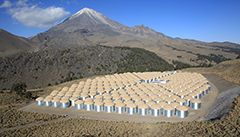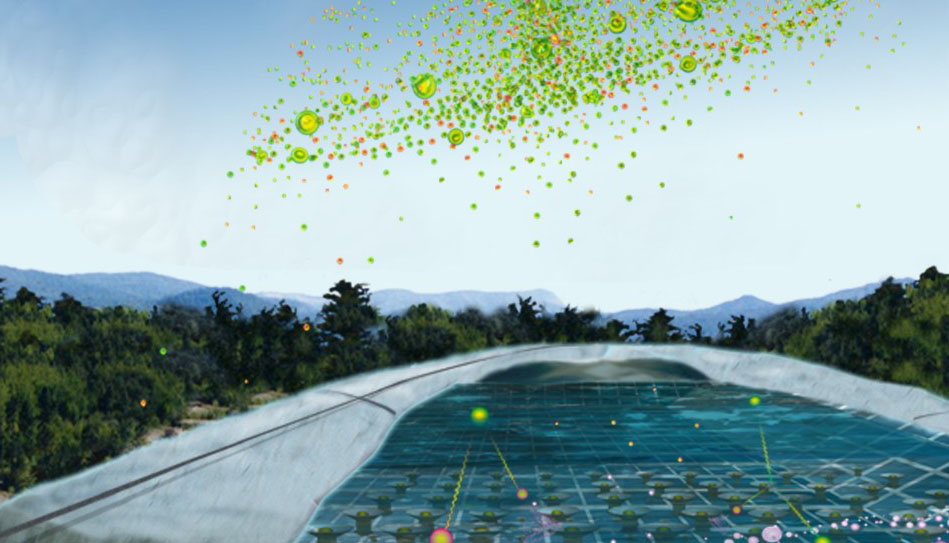 Department of Physics University of Maryland 2208G Physical Sciences Complex 301-405-6033Jordan Goodman is a Disitnguished University Professor, Chair of the University Senate and the former Chair of Physics Department at the University of Maryland. His area of research, Particle Astrophysics, studies cosmic radiation to better understand the properties of elementary particles and the processes in space that produce these particles. This field blends elements of high energy physics and astrophysics.
Department of Physics University of Maryland 2208G Physical Sciences Complex 301-405-6033Jordan Goodman is a Disitnguished University Professor, Chair of the University Senate and the former Chair of Physics Department at the University of Maryland. His area of research, Particle Astrophysics, studies cosmic radiation to better understand the properties of elementary particles and the processes in space that produce these particles. This field blends elements of high energy physics and astrophysics.
Starting with his Ph.D. work, which showed evidence for an abundance of heavy elements such as iron in high energy cosmic rays, he has worked to understand the nature of cosmic rays which hit the earth. Recently, his work has concentrated the HAWC Gamma Ray Observatory
He is the US spokesperson and Principal Investigator of the HAWC Experiment.
Awards
- 2016 Breakthrough Prize in Fundamental Physics
- Distinguished University Professor
- Distinguished Educator Award - CMNS
- Distinguished Alumni Award Dept. of Physics
- UM President's Medal
- Fellow AAAS
- ACC Teaching Scholar
- Faculty Excellence in Teaching Award Lecture - CTE
- CMPS Distinguish Alumni Award
- Kirwan Prize for Undergraduate Education
- Fellow UM Academy of Excellence in Teaching and Learning
- Richtmyer Lecture Prize– American Physical Society
- USM Regents Award for Excellence in Teaching
- UMCP Distinguished Scholar-Teacher Award
- Fellow of the American Physical Society
- UM Presidential Award for Outstanding Service to the Schools
Research
Recent/Selected Publications
Search for TeV Gamma-Ray Emission from Point-like Sources in the Inner Galactic Plane with a Partial Configuration of the HAWC Observatory By HAWC Collaboration (A.U. Abeysekara et al.). arXiv:1509.05401 [astro-ph.HE]. 10.3847/0004-637X/817/1/3. Astrophys.J. 817 (2016) 1,3
Search for gamma-rays from the unusually bright GRB 130427A with the HAWC Gamma-ray Observatory", HAWC Collaboration: A. U. Abeysekara et. al., The Astrophysical Journal 2015, 800, 78.
"The Sensitivity of HAWC to High-Mass Dark Matter Annihilations", The HAWC Collaboration: A. U. Abeysekara et al., Phys.Rev. D90 (2014) 122002; DOI: 10.1103/PhysRevD.90.122002; December 2014
"The Study of TeV Variability and the Duty Cycle of Mrk 421 from 3 Yr of Observations with the Milagro Observatory", The Milagro Collaboration: A. A. Abdo et. al., Astrophysical Journal 2014, 110, (782)
"Observation of Small-scale Anisotropy in the Arrival Direction Distribution of TeV Cosmic Rays with HAWC", The HAWC Collaboration: A. U. Abeysekara, et. al. Astrophys. J. 796 (2014) 108; DOI: 10.1088/0004-637X/796/2/108.
"Spectrum and Morphology of the Two Brightest Milagro Sources in the Cygnus Region: MGRO J2019+37 and MGRO J2031+41", The Milagro Collaboration: A. Abdo et al., ApJ 753 159 2012 doi:10.1088/0004-637X/753/2/1596
"Evidence for High-Energy Extraterrestrial Neutrinos at the IceCube Detector", IceCube Collaboration (M.G. Aartsen et al.). Nov 20, 2013. Science 342, 1242856 (2013) DOI: 10.1126/Science.1242856
"Measurement of Atmospheric Neutrino Oscillations with IceCube", IceCube Collaboration: M.G. Aartsen et al., May 16, 2013. 6 pp. Phys.Rev.Lett. 111 (2013) 081801 DOI: 10.1103/PhysRevLett.111.081801
"First observation of PeV-energy neutrinos with IceCube", IceCube Collaboration: M.G. Aartsen et al., Apr 19, 2013. 7 pp. Phys.Rev.Lett. 111 (2013) 021103, DOI: 10.1103/PhysRevLett.111.021103
"An absence of neutrinos associated with cosmic-ray acceleration in gamma-ray bursts", IceCube Collaboration: R. Abbasi et al., Nature 484, 351–354 (19 April 2012) doi:10.1038/nature11068
"Evidence for oscillation of atmospheric neutrinos", Super-Kamiokande Collaboration: Fukuda, Y., et al., Phys. Rev. Lett. 81 (1998) 1562-1567.


